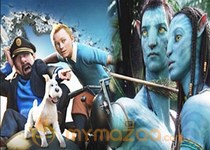Two years after breakthrough 3D megahit "Avatar," Hollywood is still struggling to decide how best to use the new technology, as filmgoers tire of the novelty and say no to annoying glasses.
While 2011 ends with a couple of well-received 3D movies - including Steven Spielberg's holiday smash "Tintin" and Martin Scorsese's "Hugo" - filmmakers need to focus on what works in three dimensions and what doesn't, say experts.
Following a series of 3D flops over the last 12 months, the coming year will see a new crop of releases, including a suped-up version of "Avatar" director James Cameron's record-breaking "Titanic" in April.
But experts say filmmakers can no longer count on the simple fact of putting "Now playing in 3D" on the posters to attract cinema-goers wary of paying a few extra bucks for a questionably improved experience.
"3D film distribution in 2011 has been a lesson in learning for studios and theaters alike," Jeff Bock, senior box office analyst at industry data provider Exhibitor Relations told.
"While there were nearly 40 (3D) films released this year, studios have been scaling back in terms of the type of films released in this new format. The reason? Audiences won't pay for a 3D engagement that isn't a premium picture."
The 3D revolution - or the latest attempt to bring 3D to cinema, following earlier failed efforts - comes as the film industry is struggling to reinvent itself as the ways of watching movies multiply.
Hollywood could arguably be said to be seeking its "iTunes moment," like the arrival of the Apple song purchasing site for the music industry, as pirate copies of films proliferated from DVDs to illegal downloads and online streaming.
But signs that 3D has struggled came this year not only from summer box office flops - "Fright Night," "Conan the Barbarian," "Glee," and "Spy Kids - but also from flagging sales of 3D televisions.







